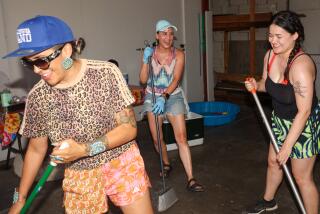OKLAHOMA CITY: AFTER THE BOMB : Seminoles and Creeks Mourn the Loss of ‘a Good Man’ : Tragedy: Respected Native American leader was in the doomed federal building trying to help find work for some elders among his people.
- Share via
WEWOKA, Okla. — A church bell summoned the Seminoles, the Creeks and their neighbors to a small brick church Saturday to mourn for a respected native American leader who lost his life in the nation’s most recent tragedy.
The death of Raymond Lee Johnson, 59, a member of the National Congress of American Indians, has been felt sharply in Wewoka, where sorrow seems to hang in the air like unsettled dust. His body was recovered last week from the wreckage of the Oklahoma City federal building, where he died in the April 19 explosion. He had gone there on an errand for other Seminoles.
“The Indians are taking Raymond’s death very hard,” said Leona Postoak, a longtime friend of the family. “Something like this just reminds them of all the other deaths and bad things that have happened to them.”
The ringing of the bell could be heard throughout this tiny community that is the official center of both the Seminole and Creek nations. But the bell probably was not necessary.
Three hundred persons already had packed the Hilltop Indian Presbyterian Church for a service that mixed the English and Muskogean languages, John 3:16 and a traditional Indian hymn for newly departed spirits. Another 100 sat on splintered and weather-beaten benches outside the church and listened to the service over a loudspeaker.
The mourning had started Friday night with prayers, songs and sermons at the church and was followed by an all-night vigil beside the casket to ensure that Johnson’s spirit would not be lonely--a Seminole tradition.
Mourners gathered hours before Saturday’s service; the women served a lunch; the children played on the lawn. Soon Johnson’s family will build a small shelter containing his belongings near his grave and guard it for four days until his footprints wash away from the earth and his spirit reaches the next world.
“Indians grieve longer than other people,” observed Kelly Tiger Jr., son of a Seminole elder. “We’ve had more practice at it.”
Tiger, in keeping with tradition, had cut his waist-length braids and burned the hair as a sign of respect for Johnson.
“We don’t have as many of our traditions as we once did but we try to hold on to those we have,” Tiger said. “That is why the children are here. Indians teach their children that death should be respected and not feared.”
Johnson, a quiet, introspective man who continued an Indian tradition of serving in the Oklahoma National Guard, held several jobs trying to improve the lot of Native Americans.
He was a counselor at Seminole Junior College, was active in promoting the Head Start program for Indian children and worked with the National Indian Council on Aging. On the day of his death he had gone to the Social Security office at the federal building to help find work for elderly Indians.
Like many Seminoles and other Native Americans, he straddled two cultures and was dedicated both to the Christian church and to the preservation of Seminole ways.
“A lot of Indians see those as conflicting,” said Corrine Postoak, a niece of Johnson. “But Uncle Raymond didn’t. He saw Christianity and the Indian ways as commingling, not conflicting.”
One sign of his respect for both traditions was visible as his casket was lowered in the family cemetery at the home of his brother.
The casket had been draped by an American flag, which was presented to the family by a veterans organization. As it was put into the ground, the coffin had an Indian blanket on its top.
At the funeral, his son Anthony, a sergeant in the Oklahoma National Guard, looked at his father in the open casket, gave a crisp salute and broke into tears. Later several women had to be supported after nearly collapsing.
Wewoka, 75 miles from Oklahoma City in the gentle green hills of eastern Oklahoma, became the capital of the Seminole Nation in the mid-19th Century after the forced relocation of the tribe from Florida and Georgia.
The war between the Seminoles and the U.S. Army, according to historians, was the bloodiest of the Indian wars.
The community still bears some signs of those conflict-laden years after relocation. Seminole Street, just east of Main Street, divided the Seminole and Creek nations. A spreading pecan tree in the town square is still known as the whipping tree because Indians who had broken tribal law were called there by elders for punishment.
*
Although it is now quiet, with only 5,000 residents, Wewoka was an oil boom town. Historians suggest that the tribe gained little from the gushers on their property because unscrupulous wildcatters swindled them.
The Seminoles have been hurt by another economic shift: the flight of the apparel industry to cheaper labor markets in Mexico. Three apparel factories in Wewoka have closed, throwing many Seminoles out of work.
In recent years, Johnson had lived in Oklahoma City, where there was a church service for him Friday, but the family wanted him buried in Wewoka.
“We felt we should bring him home,” Postoak said. “His spirit will be happy here.”
More to Read
Sign up for Essential California
The most important California stories and recommendations in your inbox every morning.
You may occasionally receive promotional content from the Los Angeles Times.










